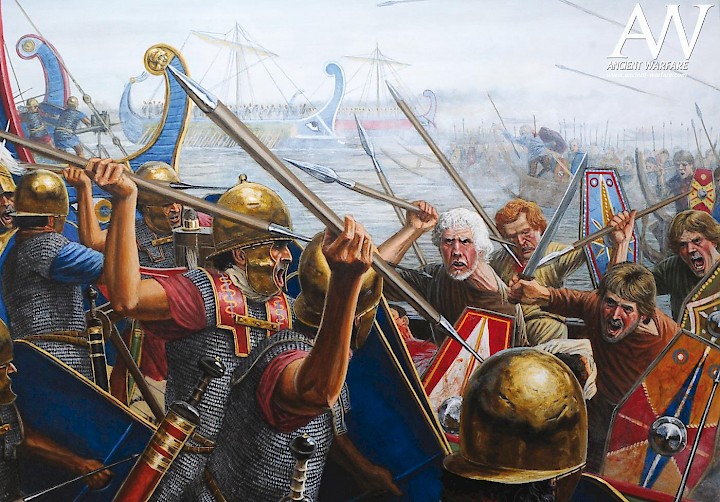Wars at the edge of empires
Last week, I put the finishing touches to the latest issue of Ancient Warfare. As long-time readers are probably aware, every volume of the magazine features six issues, two of which deal with a Greek topic, two with a Roman subject, one with a non-Graeco-Roman theme, and finally an issue that deals with a broader topic that cuts across periods and cultures.
Issue X.4 is volume X’s entry for the last category. In many ways, these are some of the hardest issues to put together, since it’s easy for them to come across as less focused than any of the other types of issues. So far, though, I don’t think I’ve done too badly at forging issues like this into a cohesive whole, and I’m happy with how issue X.4, on the theme of ‘wars at the edge of borders’, has panned out.
I wrote the brief historical introduction to the issue myself. The ‘Source’ article for this issue was written by regular contributor Sean Manning and deals with ostraca recovered near Arad in the Levant and gives some idea of what it was like to live in the Persian Empire, close to Egypt. Manousos Kambouris’ contribution deals with the Trojan War, which – if deemed historical – took place at the fringes of the Hittite Empire, with an illustration by Fabrice Weiss depicting Achilles in combat. Gareth Williams has written about the threats to – and eventual collapse of – the Assyrian Empire.
The remaining articles of this issue all deal with Rome. Marc DeSantis’ article deals with Corbulo, who had to clean up a mess in Armenia on the orders of Nero. It is beautifully illustrated by Azat Kuzhin, a new addition to our stable of illustrators. Sidney Dean’s feature article, illustrated once again by Seán O’Brógáín, focuses on Drusus’ campaign across the Rhine in 12 BC.
 Andrei Pogacias’ short article deals with the Roman frontier in Dacia. New writer Béla Santa moves us to Hungary and deals with the so-called Devil’s Dyke, another part of the Roman limes. Ian Ross’s short article is on the Picts in the north of Britain and the problems they posed Rome. The latter is especially interesting to geeks, since it includes a picture of a Roman dice tower from Germany that Ian discussses in more detail in his article.
Andrei Pogacias’ short article deals with the Roman frontier in Dacia. New writer Béla Santa moves us to Hungary and deals with the so-called Devil’s Dyke, another part of the Roman limes. Ian Ross’s short article is on the Picts in the north of Britain and the problems they posed Rome. The latter is especially interesting to geeks, since it includes a picture of a Roman dice tower from Germany that Ian discussses in more detail in his article.
As far as the non-theme-related articles are concerned, Justin Swanton offers a fresh interpretation of the Macedonian cavalry wedge, while Duncan Campbell tries to answer the question if the Praetorian Guard were an honour guard or elite strike force. Graham Sumner’s turn at ‘Hollywood Romans’ deals with the 1959 movie version of Ben-Hur.
This issue also brings a few important changes to Ancient Warfare. As of this issue, Lindsay Powell won’t be handling the news anymore on pages 4 and/or 5. Since the editors for Medieval Warfare and Ancient History Magazine each handle the news themselves, I figured it would be odd if Ancient Warfare’s editor continued to rely on someone else to do that for him. But I do want to thank Lindsay heartily for his contributions in the past and you can look forward to more regular articles by Lindsay in future issues of the magazine.
The biggest change that you will notice has to do with the magazine’s presentation. Following Medieval Warfare issue VI.4, Ancient Warfare now has a brand new interior layout. Here’s an example of a two-page spread with a beautiful illustration by Julia Lillo:
 The magazine now looks a little more like The Art of Ancient Warfare, but Christy Beall, our talented designer, added all sorts of fun features, including art taken from Minoan wall-painting that illustrates the first page of every article. I think you’ll like it, and I definitely want to hear your opinion about this change.
The magazine now looks a little more like The Art of Ancient Warfare, but Christy Beall, our talented designer, added all sorts of fun features, including art taken from Minoan wall-painting that illustrates the first page of every article. I think you’ll like it, and I definitely want to hear your opinion about this change.
You can pre-order issue X.4 via our webshop or subscribe to the magazine.

